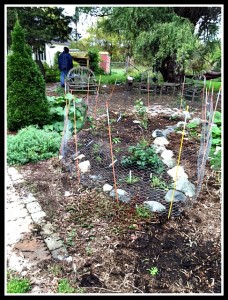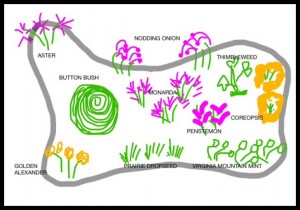
My new native garden looks a bit bare at present, but it includes 19 bee-and-butterfly-pleasing plants.
Today, I helped create my first totally native plant garden. I and the person who helps me in the garden planted 17 new natives to accompany the two that were already there. (This same bed formerly held overgrown day lilies that I had grown thoroughly tired of. Therefore, the crescent-shaped bed itself was already made.)
In its new iteration, the bed is in its infancy and is therefore not beautiful. But I am confident that it will be in a year or two.
Design Considerations
As we designed the garden, we aimed to complement the two existing plants, a button bush and a thimble weed, both planted last year, both doing well. We put the tallest plants — wild monarda, or bee balm (3), and penstemon (2) — in the middle. Around the edges, we planted Virginia Mountain mint (3), prairie dropseed grass (3), nodding wild onion (2), coreopsis (2), and golden alexander (1). At the end of the garden, where it extends out further, we planted an aster. We purchased all these plants (plus a few more) last weekend at the annual Native Plant Sale at Matthaei Botanical Gardens. We bought the original two there at last year’s sale.
Here is the design we came up with, as we designed “on the fly”:

This hand-drawn picture is not drawn to scale. The actual garden is about 12 feet long and 4 to 5 feet wide.
Bloom Schedule
In a native garden, the idea is to have the “bee and butterfly buffet” open as long as possible. It should provide food for bees and butterflies — as well as moths, birds, and other pollinators — from early in the season all the way through to late fall.
According to my references, the bloom schedule for this garden will be as follows:
- April – May: Golden alexander, penstemon
- May – June: Button bush, coreopsis, golden alexander, nodding wild onion, penstemon, thimbleweed
- June – July: Monarda, nodding onion, thimbleweed
- July – August: Monarda, mountain mint, nodding wild onion, prairie dropseed
- August – September: Mountain mint, prairie dropseed
- September – October: Aster, monarda, prairie dropseed
I also plan to sprinkle bulbs, probably muscari, throughout this garden for even earlier spring bloom that pollinators like.
The colors of these plants are generally white, yellow and purple, which seem to be predominant in the native plant world.
Why Plant Native?
According to the U.S. Fish and Wildlife Department, plants native to your area will attract more native pollinators. They note that “native plants can [also] serve as larval host plants for some species of pollinators.”
The Xerces Society, in its book Attracting Native Pollinators, reiterates this point. It quotes Gordon Frankie’s research, which “demonstrates that native plants are four times more likely than nonnative plants to attract bees. The presence of native vegetation “significantly increases the abundance of butterflies and moths.” If you would like a copy of this wonderful book for yourself, you can find it by scrolling down on the Xerces Society’s webpage.
Research by Douglas Tallemy and his colleagues at the University of Delaware came to a similar conclusion, with native plants supporting three times as many butterfly and moth species as introduced plants. Native woody plants, the researchers found, supported 14 times as many species as introduced ornamental species!
Finally, native plants offer many benefits to the gardener as well, as they:
- Do not require fertilizers, meaning no fertilizer to purchase and use
- Do not require pesticides for maintenance, meaning no poisons to store, watch over, and spread
- Require less watering, saving time, effort, and money
- Are less likely to become invasive, making the gardener’s work easier
- Promote local biological diversity, making your garden a more interesting and entertaining place and doing good for the environment
Perhaps the better question would be, “Why on earth would you NOT use native plants?” My own philosophy is that the garden can have many native plants in it plus a few of the gardener’s favorite ornamental plants. Something for everyone — that’s the middle road that seems right to me on this thorny issue.
Definitely a Work in Progress
As many gardeners do, I sometimes make the mistake of underestimating the size of mature plants. I may have done so this time. Right now, the seedlings are tiny things with what looks like lots of room between them. The good thing is, if they grow up to need more room, we can always move them somewhere else. In the process, we will make the garden as a whole more attractive to pollinators. As for color, if I get thoroughly sick of purple, yellow and white, I might just throw a few orange zinnias in there for a little pizazz. I don’t think the butterflies and bees will mind too much, do you?
Other Posts that Might Interest You
4 Ways to Create Habitat for Native Bees
A Review of A Sting in the Tale: My Adventures with Bumblebees
Six Cheap, Easy Things You Can Do to Help the Bees — Including How to Build a Bee Hotel
Like this post? Sign up to receive an email each time a new post is available. We will never loan, sell or rent your email address — that’s a promise! Please use the buttons below to share with others.